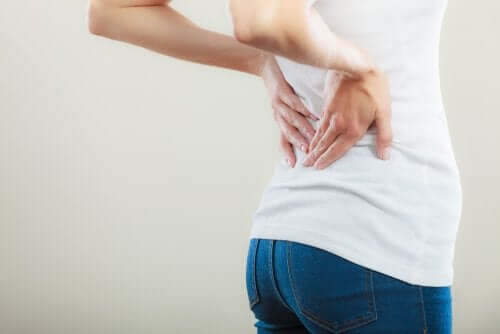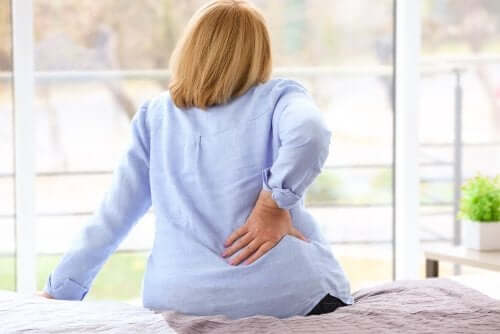How to Relieve Back Pain After Giving Birth

Back pain after giving birth is a much more common issue than you may think. In most cases, it has to do with the major physical changes that take place in a woman’s body during pregnancy… especially in regards to weight and posture. They can also have to do with the amount of effort women must make with their muscles when giving birth.
“Though lumbar and pelvic pain is the most frequent complication of pregnancy, its etiology and physiopathology are poorly understood. The normal physical changes that occur in pregnancy could also affect the spine and contribute to the appearance of lumbar pain during gestation and possibly during postpartum as well.”
– Milan Munjin, Francisco Ilabaca, Juan Rojas –
Other possible causes of this postpartum complication are: The accumulation of water in the body, congestion in the epidural blood vessels and changes in the endocrine system.
In terms of movement, women are constantly bending over and picking their babies out of their cribs and playpens and off the floor. This can intensify the pain and discomfort that women feel.
Recommendations for back pain after giving birth
- Set out to get down to your ideal weight as soon as possible. Improve your eating habits with a healthy quality diet. That way, your vertebrae won’t have to bear any excess weight and your muscles will be able to relax.
- Practice physical activities like yoga, swimming, walking, or go to the gym. These exercises help to strengthen your muscles and ligaments that have lost their natural tone. They also allow you to increase your flexibility and resistance. You should focus especially on exercising your pelvic area.
- Make sure to get enough quality sleep and allow your body to rest physically. In this sense, you should avoid high-impact or physically intense activities. These can easily make your back pain after giving birth even worse. Also, you should avoid picking up heavy objects or squatting and bending over for too long.
- Maintain good posture when you’re sitting down. In the same way, when it comes to feeding your baby, avoid leaning over to one side. Sit with your back straight and lean back against a comfortable surface. Also, while sitting, rest your feet on a small footstool. Keeping your legs elevated will reduce direct pressure on your lumbar muscles.

- Take warm baths and put a hot compress on your back at night. These simple home remedies will help your muscles to relax if they’re too tight. For even better and more noticeable results, you can use natural salts or aromatic plants that have anti-inflammatory properties.
- Ask for someone to give you a massage. The hands of a professional can help realign your muscles and give them back that proper shape. What’s more, massages reduce swelling and accumulated tension. If you don’t have access to a professional massage, you can turn to your partner or a friend or relative.
Other special care
- Avoid using high heel shoes for several months after giving birth. This will help you avoid exposing your feet and spinal cord to excess pressure.
- Apply hot and cold compresses on your pack, alternating between each one.
- Use ointments and essential oils in the area where you’re experiencing pain.
- Make a point to carry your baby in front of you rather than on your hip. That way you’ll avoid overexerting the muscles in your hip and back.
- When you pick your child up off the floor, avoid stretching your arms out too far. Get a little closer and don’t bend over without bending your knees. Rather, the correct position involves squatting down with bended knees and using your legs muscles to help you get back up.
- Practice relaxation and breathing exercises that help you relieve muscle tension brought on by stress.
When should I see a doctor about my pack pain after giving birth?
On some occasions, women who are experiencing back pain after giving birth need to see a doctor about the issue. If any of the following are true for you, schedule an appointment with your doctor:
- When the pain is severe and gets worse with time, rather than getting better.
- If you have a fever.
- If the pain is the result of a serious bump or a fall.
- When one or both of your legs are feeling numb.
- If you’re experiencing a loss of coordination or experiencing extreme exhaustion.
- When the pain in your body persists for more than six months.

All of the suggestions that you read in today’s article are part of a healthy lifestyle. Depending on how well you care for yourself, you can get over the bothersome issue of back pain after giving birth.
Don’t hesitate to consult a professional if you experience one or more of the symptoms we mentioned above. You may require more than simple home remedies to solve your problem.
Back pain after giving birth is a much more common issue than you may think. In most cases, it has to do with the major physical changes that take place in a woman’s body during pregnancy… especially in regards to weight and posture. They can also have to do with the amount of effort women must make with their muscles when giving birth.
“Though lumbar and pelvic pain is the most frequent complication of pregnancy, its etiology and physiopathology are poorly understood. The normal physical changes that occur in pregnancy could also affect the spine and contribute to the appearance of lumbar pain during gestation and possibly during postpartum as well.”
– Milan Munjin, Francisco Ilabaca, Juan Rojas –
Other possible causes of this postpartum complication are: The accumulation of water in the body, congestion in the epidural blood vessels and changes in the endocrine system.
In terms of movement, women are constantly bending over and picking their babies out of their cribs and playpens and off the floor. This can intensify the pain and discomfort that women feel.
Recommendations for back pain after giving birth
- Set out to get down to your ideal weight as soon as possible. Improve your eating habits with a healthy quality diet. That way, your vertebrae won’t have to bear any excess weight and your muscles will be able to relax.
- Practice physical activities like yoga, swimming, walking, or go to the gym. These exercises help to strengthen your muscles and ligaments that have lost their natural tone. They also allow you to increase your flexibility and resistance. You should focus especially on exercising your pelvic area.
- Make sure to get enough quality sleep and allow your body to rest physically. In this sense, you should avoid high-impact or physically intense activities. These can easily make your back pain after giving birth even worse. Also, you should avoid picking up heavy objects or squatting and bending over for too long.
- Maintain good posture when you’re sitting down. In the same way, when it comes to feeding your baby, avoid leaning over to one side. Sit with your back straight and lean back against a comfortable surface. Also, while sitting, rest your feet on a small footstool. Keeping your legs elevated will reduce direct pressure on your lumbar muscles.

- Take warm baths and put a hot compress on your back at night. These simple home remedies will help your muscles to relax if they’re too tight. For even better and more noticeable results, you can use natural salts or aromatic plants that have anti-inflammatory properties.
- Ask for someone to give you a massage. The hands of a professional can help realign your muscles and give them back that proper shape. What’s more, massages reduce swelling and accumulated tension. If you don’t have access to a professional massage, you can turn to your partner or a friend or relative.
Other special care
- Avoid using high heel shoes for several months after giving birth. This will help you avoid exposing your feet and spinal cord to excess pressure.
- Apply hot and cold compresses on your pack, alternating between each one.
- Use ointments and essential oils in the area where you’re experiencing pain.
- Make a point to carry your baby in front of you rather than on your hip. That way you’ll avoid overexerting the muscles in your hip and back.
- When you pick your child up off the floor, avoid stretching your arms out too far. Get a little closer and don’t bend over without bending your knees. Rather, the correct position involves squatting down with bended knees and using your legs muscles to help you get back up.
- Practice relaxation and breathing exercises that help you relieve muscle tension brought on by stress.
When should I see a doctor about my pack pain after giving birth?
On some occasions, women who are experiencing back pain after giving birth need to see a doctor about the issue. If any of the following are true for you, schedule an appointment with your doctor:
- When the pain is severe and gets worse with time, rather than getting better.
- If you have a fever.
- If the pain is the result of a serious bump or a fall.
- When one or both of your legs are feeling numb.
- If you’re experiencing a loss of coordination or experiencing extreme exhaustion.
- When the pain in your body persists for more than six months.

All of the suggestions that you read in today’s article are part of a healthy lifestyle. Depending on how well you care for yourself, you can get over the bothersome issue of back pain after giving birth.
Don’t hesitate to consult a professional if you experience one or more of the symptoms we mentioned above. You may require more than simple home remedies to solve your problem.
All cited sources were thoroughly reviewed by our team to ensure their quality, reliability, currency, and validity. The bibliography of this article was considered reliable and of academic or scientific accuracy.
- Pérez Pérez, A. C. (2020). Beneficios de la práctica del Método Pilates durante el embarazo y postparto para el binomio madre-hijo. https://uvadoc.uva.es/bitstream/handle/10324/42054/TFG-H1951.pdf?sequence=1&isAllowed=y
- Chavarría SJ. (2014). Lumbalgia: Causas, diagnóstico y manejo. Revista Médica de Costa Rica y Centroamérica, 71(611):447-454. https://www.studocu.com/es-mx/document/universidad-tecnologica-de-mexico/deporte-y-medicina/lumbalgia-caus-as-diagnostico-y-manejo/21869570
- Bajar de peso después del embarazo. (s. f.). MedlinePlus. https://medlineplus.gov/spanish/ency/patientinstructions/000586.htm
- ¿Cuántas calorías deben consumir las mamás y los bebés durante el amamantamiento?. (2019). Instituto Nacional de la Salud infantil y Desarrollo Humano Eunice Kennedy Shriver. https://espanol.nichd.nih.gov/salud/temas/breastfeeding/informacion/DGA#f3
- Montes-Tejada, A., Sánchez-García, J., Merino-García, E., Molina-Martínez, E., & Rodríguez-Blanque, R. (2020). El ejercicio físico en el embarazo y/o el posparto frente a la fatiga percibida. Journal of Negative and No Positive Results, 5(3), 329-346. https://dx.doi.org/10.19230/jonnpr.2916
- Ejercicio. (2020). Mother To Baby, Fact Sheets. Brentwood (TN): Organization of Teratology Information Specialists (OTIS). https://www.ncbi.nlm.nih.gov/books/NBK582698/
- Andrade Rebolledo, D., & Vicente Parada, B. (2018). Fatiga postparto: revisión de la literatura. Revista chilena de obstetricia y ginecología, 83(2), 161-169. https://dx.doi.org/10.4067/s0717-75262018000200161
- Blas, C., López, S., & Ramos, E. (2015). Curso básico sobre dolor. Tema 3. Lumbalgia. Abordaje farmacéutico. Farmacia Profesional, 29(3), 40-48. https://www.elsevier.es/es-revista-farmacia-profesional-3-articulo-curso-basico-sobre-dolor-tema-X0213932415346405
This text is provided for informational purposes only and does not replace consultation with a professional. If in doubt, consult your specialist.








